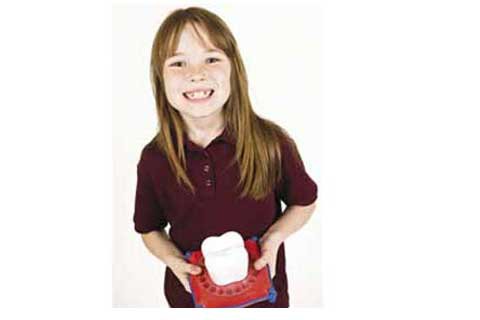
Tooth Fairy
It seems like just days ago when I waited patiently for my son’s first little biters to erupt in his infant mouth. Those days somehow melted magically into years and before I knew it, I could hear the Tooth Fairy getting ready to flutter about. Like many parents, I wondered: what is developmentally normal when it comes to baby tooth loss; how does the tooth-obsessed fairy collect her pearly prizes; and what is the paying pixie’s going rate for a baby tooth these days?
Losing Baby Teeth
According to Dr. Randy Raetz, a Rochester-based dentist, a child’s first adult molars usually come in around age 6 (there are no baby teeth that these replace). The first baby tooth lost is usually the central incisors, typically around age 7.
Should you yank a loose tooth? “If a baby tooth is wiggly, then yes, go ahead and loosen it up,” says Ratez. “If you are unsure, or afraid, or the child is afraid, see your dentist.” If your child is anxious about the loose tooth, Ratez recommends that parents avoid using words like shot, pain, needle, and hurt. “Use the term pressure and wiggle,” he says. “If you tell the child this is not going to hurt, then they are going to think it is going to hurt. ” How can you help a loose tooth along? Ratez suggests wiggling it back and forth. Apples and sticky foods help too!
Enter the Tooth Fairy
The Going Rate
According to a 2013 survey conducted by Visa, kids are receiving an average of $3.70 per tooth. That’s up from $2.60 per tooth in 2011 — a 42 percent jump. The Tooth Fairy was particularly generous to kids in the Northeast, leaving an average of $4.10 per tooth. Kids in the West and South trailed with an average of $3.70 and $3.60 respectively.
That first loose tooth can cause anxiety for some children. Often, anxiety turns to excitement as children listen to tooth-loss stories exchanged among classmates and anticipate the reward the Tooth Fairy leaves behind.
While the exact origin of the enigmatic Tooth Fairy is steeped in mystery, historically the loss of baby teeth is an important rite of passage. The earliest known written records regarding baby teeth date from northern Europe and describe a tann-fe, or tooth fee, in which money was paid for a baby tooth. In the Middle Ages, Europeans, fearing witches could curse their children if they acquired their baby teeth, buried the teeth in the ground. The Vikings wore baby teeth as jewelry, considering them good luck talismans in battle. Other cultures fed the teeth to animals believing the adult tooth would resemble the animal’s powerful, strong teeth.
Today, countries all over the world continue to mark the loss of baby teeth with various customs. In Spain, France, Italy and Mexico, for example, the Tooth Fairy appears as a small white mouse or rat, symbolic because rodents have strong teeth that never stop growing. In Sweden, the baby tooth is placed in a glass of water where it is mysteriously replaced overnight with coins. And, it is customary in much of the Middle East for baby teeth to be thrown towards the sun and in Asia, onto the roof.
The Tooth Fairy as many of us know her, appeared in the early 1900s.
Cups, Pillows, Pockets and Doors
The Tooth Fairy isn’t picky about how she collects baby teeth. Lori Poland grew up placing her baby teeth in a clear glass of water on her nightstand. She says she loved fishing a wet $2 bill out of the cup the next morning, setting it out to dry and storing it in her memory box.
Although a tooth placed in a plastic ziplock bag or envelope tucked under the pillow should do the trick, many parents opt for a Tooth Fairy pillow or pouch for their youngster. Retailers offer an assortment of pillows or try making your own.
Monica Bradford designed a Tooth Fairy Pocket for her 6-year-old son when he lost his first tooth. “He placed his tooth in the pocket, hung it on his bedpost and woke up to find $2 for his first tooth,” she says. (For instructions on making your own Tooth Fairy Pocket, visit Bradford’s blog http://scrapinspired.com/2011/10/tooth-fairy-pocket/.)
Cathy Green, mom of three, says the Tooth Fairy enters their home through a small ceramic door that Green’s step-mother designed. The door is outside the kids’ bedrooms. After collecting the tooth from a small box under the child’s pillow, the Tooth Fairy replaces the tooth with her reward and leaves the box next to the tiny door.
What Does the Tooth Fairy Do with Those Teeth?
Legend says that the Tooth Fairy tosses the teeth up to the sky and they become stars. Naturally, many theories exist. Foster’s daughter Logan says, “The fairy uses her wand to shrink the teeth to a very small size so she can carry them in a bag with her from house to house. She then takes the teeth to Santa so he can use them to make toys.”
Whatever she does with them, with each tooth lost, adulthood gains another foothold on our kids. No wonder throughout the ages we’ve found ways to mark this stage in our kids’ lives, which seems as fleeting as the Tooth Fairy herself.
Freelance journalist Christa Melnyk Hines is a mom of two boys and the author of Confidently Connected: A Mom’s Guide to a Satisfying Social Life, a resource for moms seeking a more balanced social life that supports their emotional health. She is a regular contributor to Rochester & Genesee Valley Parent Magazine.
Views: 0





